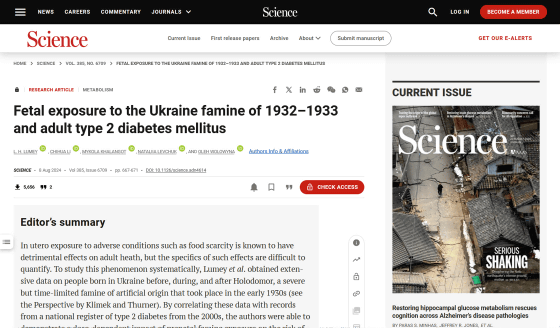It turns out that the famine that occurred in Ukraine in the 1930s influenced the incidence of type 2 diabetes 70 years later

Between 1932 and 1933, a great famine known as
Fetal exposure to the Ukraine famine of 1932–1933 and adult type 2 diabetes mellitus | Science
https://www.science.org/doi/10.1126/science.adn4614

1930s Famine Continued to Affect Ukrainian Health 7 Decades Later : ScienceAlert
https://www.sciencealert.com/1930s-famine-continued-to-affect-ukrainian-health-7-decades-later
The Holodomor was a great famine caused by a combination of the suppression of ethnic movements, the campaign to eradicate the kulak (rich peasants) , the collectivization of agriculture through kolkhoz , and the forced requisitioning of grain, all of which were promoted by Joseph Stalin , the leader of the Soviet Union at the time. As a result, several million people are said to have died of starvation in Ukraine between 1932 and 1933.
Even at that time, Ukraine was one of the leading grain-producing regions in Europe, and exports of Ukrainian wheat were a valuable way for the Soviet Union to earn foreign currency, so even when famine occurred, grain requisitions did not stop and continued to be exported. Furthermore, the Stalin regime also controlled information, such as banning reports of the famine within the country, and insisted to the international community that 'there was no famine in Ukraine,' refusing calls for assistance through the International Red Cross. For this reason, the Holodomor is considered to have been an artificial and man-made famine.

In recent years, it has been known that the health and nutritional status of the mother also affects the fetus, and the Holodomor famine may have had an impact on subsequent generations. Therefore, a research team led by
The study used birth records of approximately 10.18 million people born in Ukraine between 1930 and 1938, as well as data on 128,225 people diagnosed with type 2 diabetes between 2000 and 2008. Data on time of birth, gestational age calculated backwards from that, place of birth, and risk of developing type 2 diabetes later in life were analyzed.
The researchers found that 'people born in the first half of 1934 in famine-hit oblasts in Ukraine were more than twice as likely to develop type 2 diabetes later in life.' The researchers noted that these women were pregnant in the first half of 1933, the year of the greatest Holodomor deaths. More than 80% of Holodomor deaths occurred between January and July 1933, when an estimated 28,000 people died per day.
However, people exposed to famine during mid-to-late pregnancy or shortly after birth did not have an increased risk of developing type 2 diabetes.

The findings suggest that it may only be during the early stages of pregnancy that malnutrition increases the risk of metabolic diseases, including type 2 diabetes, later in life. 'While the likelihood of being diagnosed with type 2 diabetes depends on many factors, exposure to starvation during the Holodomor appears to be a dominant factor that outweighs all others,' the team concluded.
Related Posts:
in Science, Posted by log1h_ik







